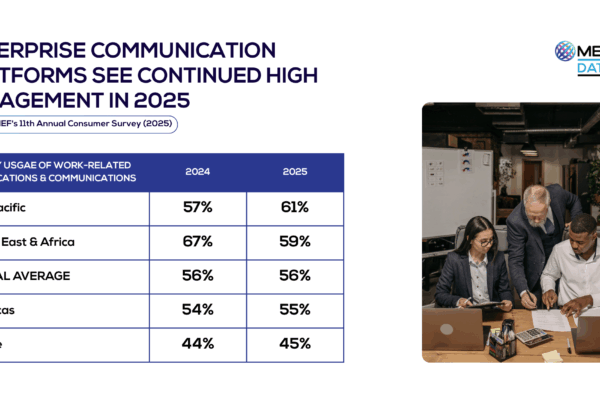MEF’s Riccardo Amati explains that AT&T’s latest quarterly results highlight a telecom giant in transition — balancing growth with heavy investment and navigating an increasingly converged mobile and broadband landscape. As the company leans into integration and next-generation connectivity, its strategy offers clues to where the U.S. communications market may be heading next.
ARPU dips as aggressive promotions weigh on results. Meanwhile, AT&T invests in fiber, 5G spectrum, and integrated networks, setting the stage for a new phase in the U.S. mobile ecosystem.

AT&T’s third-quarter revenue rose slightly from a year earlier but missed Wall Street forecasts. Average revenue per user fell. The shortfall came from aggressive promotions meant to win customers in a crowded market. Price pressure is now constant in U.S. wireless. Margins tighten. Scale and convergence are the new ways to grow.
For the mobile ecosystem — ad networks, messaging firms, app developers — this shift matters. Business will follow the data. As carriers push bundles and connected services, the industry must adapt to networks designed for integration, not stand-alone plans.
Revenue reached $30.7 billion, up 1.6%, short of the $30.86 billion expected. Postpaid phone Average Revenue Per User (ARPU) fell 0.8% to $56.64, pulled down by discounts and trade-in offers.
Stankey’s bet is simple: that connectivity itself will be the base layer for all digital services.“
Staying Inside One Network
“We’re focused on converged customers,” said CEO John Stankey. “We know there are some things we have to do differently for that to happen.”
He wants customers to stay inside one network — mobile, broadband, and home internet under one bill. He said 41% of fiber users also take mobile plans, proof that the model works. “We get happier customers who ultimately move up the continuum, buy more,” he said.
AT&T added 405,000 postpaid phone customers and 288,000 fiber customers in the quarter. Churn rose to 0.92%, showing how fierce the market has become. The company’s Internet Air service added 270,000 users, reaching most U.S. states.
Convergence gives AT&T more than subscribers. It gives data — on devices, streaming, and spending. That data drives how services evolve. It connects telecom economics with the ad, fintech, and app sectors that depend on network behavior.
Investment Before Margin
Earnings per share were $0.54, flat from a year ago. Operating income was $6.1 billion, adjusted to $6.6 billion. Free cash flow reached $4.9 billion. Capital spending matched that figure. The money went to fiber build-outs and spectrum.
During the quarter, AT&T agreed to buy 50 MHz of spectrum from EchoStar for $23 billion. It also announced a $5.75 billion acquisition of Lumen’s fiber assets, adding five million connections. Stankey said these moves would “enhance and expand our advanced connectivity portfolio.”
The new spectrum will strengthen 5G coverage. AT&T said mid-band licenses will reach two-thirds of the U.S. population by mid-November. The Lumen deal extends fiber into smaller cities, giving AT&T a single footprint for both home and mobile data.
The cost is debt. The company expects net debt to reach about three times EBITDA. It plans to fund the EchoStar purchase with cash and borrowing. Stankey said free cash flow would stay above $16 billion for 2025, supporting the dividend.
The numbers tell a trade-off: slow revenue growth, rising investment. The company is building capacity before it builds margin. Growth today funds infrastructure for tomorrow’s services — connected cars, home IoT, and low-latency applications.
Mobility revenue rose 2.3% to $16.9 billion. Business wireline fell 8%, reflecting the decline of legacy voice. AT&T is shedding the old to make room for new connectivity models.
Networks as Platforms
AT&T’s direction affects more than its shareholders. It sets the pace for how mobile networks evolve in the U.S. The fiber and 5G grid it builds will define what developers, advertisers, and startups can do. Similar moves are underway in Europe. Vodafone uses fixed-mobile bundles to reduce churn. Telefónica combines fiber and mobile to cross-sell digital services. Orange links home and mobile into one offer while adding banking, cybersecurity, and IoT.
For app builders, it means faster networks and broader reach. For advertisers, richer real-time data from linked home-and-mobile profiles. For startups, a platform where mobile and fixed lines blend into one continuous digital space.
The model favors embedded mobile services — payments, connected homes, health monitoring, streaming tied to user identity and location. These need low latency and stable data channels. That is what AT&T is selling now: not calls, but capability.
Convergence makes it harder for smaller players. Mobile virtual operators and niche providers rely on wholesale access to big networks. Their chance to compete moves from building infrastructure to creating software — APIs, analytics, and interfaces that let users and apps take full advantage of the network.
The winners will be those who can plug into a major telecom’s infrastructure and add value without owning it. Entrepreneurs who understand network behavior — how users move between devices and connections — will find space to grow.
Stankey’s bet is simple: that connectivity itself will be the base layer for all digital services. The challenge is to turn that layer into profit while ARPU falls. That will test the industry’s ability to create new demand without raising prices.
AT&T’s results show the tension of that shift. The company grows customers but not margin. It spends billions to hold ground in a market where every user is already connected. Its answer is integration — sell one connection, extend it everywhere.
That model, if it works, changes the economics of the mobile world. It ties service design to infrastructure again. Developers, advertisers, and platforms will have to build with the network in mind — not above it.
The next phase of mobile will depend on who can merge access, data, and intelligence. AT&T is building the backbone for that merge. Its place as a platform will hinge on how fast scale becomes value. How the industry uses it — for services, apps, or new models — remains to be seen. The network is there. Its impact will.





